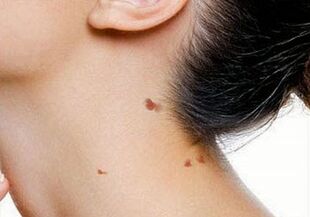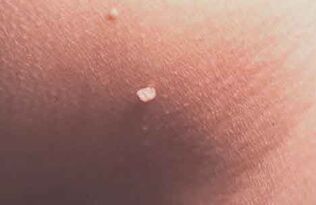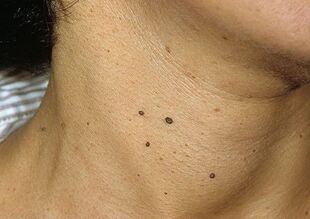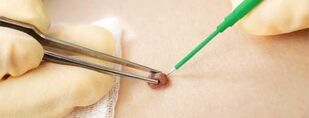
Neck papillomas (filamentous warts) are the result of human papillomavirus infection caused by human papillomavirus (HPV) entering or activating cells. This localization of neoplasms is common. Experts call such papillomas filiform warts (acrocord). They can be seen not only on the neck, but also under the armpits, behind the ears, and under the mammary glands.
It is the task of specialists to determine the causes and choose methods for the treatment of papillomas in the neck. Human papillomavirus infection is dangerous to health, especially in combination with genital warts and urogenital diseases, which can lead to the growth of malignant tumors.
Disease development mechanism
Papillomavirus is found in most sexually mature people. HPV enters the body through damage, cracking, massage, using other people's hygiene products, shoes, as well as through unprotected sex. For months or even years, the papillomavirus does not manifest itself in any way, indicating that it is a chronic carrier. When viruses multiply in the surface layers of the skin, tissue hyperplasia occurs, and filamentous growth occurs in the neck and other parts of the body.
Important! HPV is not resistant to the environment. The virus dies rapidly on household items. Infection occurs mainly through direct contact.
Manicure during shaving, self-infection is possible when a lying virus is active. The disease progresses to the stage of active clinical manifestations, followed by hyperplastic processes in the skin.
Causes of papillomas in the neck

It is impossible to say exactly why papillomas appear in the neck. Experts identify the following factors:
- Transplantation of severe infectious diseases, surgical interventions that weaken the immune system, reduce the body's ability to adapt;
- Frequent skin damage with clothing, hygiene and care products;
- Massage by HPV-infected workers in low-quality salons with non-compliance with infectious safety precautions;
- hormonal disorders, endocrine pathologies;
- Presence of other types of papillomas, genital warts and warts on the body and genitals.
Experts believe that the causes of papillomas in the neck may be due to hormonal changes in the body. This confirms that filamentous warts often occur after endocrine pathologies, during pregnancy and menopause, when the activity of sex hormones decreases.
In young women, the cause of cervical papilloma is often ovarian dysfunction. But first, HPV must be in a passive form in the body. Hormonal fluctuations are just a trigger.
Clinical manifestations
Papillomas of the neck have virtually no clinical manifestations. Externally, they resemble small filamentous plants with a yellowish or fleshy color. Neoplasms have a fairly dense consistency. Dimensions rarely exceed 6 mm. Often filamentous papillomas of the neck occur in small groups, can grow together and form foci resembling cockroaches or cauliflower.
This type of papillomatous growth is not prone to magnetism, but if damaged, there is a risk of tissue malignancy. Neoplasms can become inflamed, often causing new papillomas to spread to healthy skin.
Examination of papillomas in the neck
During a thorough examination, it is possible to determine the causes and treatment of papilloma of the neck. You should consult a dermatologist when filamentous growths appear.
Basic diagnostic methods for papillomas in the neck, armpits and other parts of the body:

- PCR;
- dermatoscopy;
- biopsy of neoplasmic tissues;
- histological examination.
Papillomas of the neck differ from common warts, fibroids, moles. The virus can be detected during PCR examination. This method allows you to determine the DNA of the virus, assess the oncogenicity of the formation and the amount of HPV. The most dangerous types of HPV that cause cervical cancer are type 16 and 18.
Papilloma tissue biopsy is performed if a malignant process is suspected. Chronic papillomavirus infection contributes to tissue hyperplasia and often leads to magnesis. Therefore, it is important to detect viruses with high oncogenic risk in a timely manner and eliminate papillomatous growths.
Treatment methods
The treatment regimen for cervical papilloma is selected individually. This is taken into account:
- number of neoplasms, their shape and size;
- general health condition of the patient;
- degree of malignancy risk of neoplasms;
- Existence of diseases, including external and internal tumors, urogenital infections.
To understand how to get rid of papillomas in the neck, your doctor will order a thorough examination, make sure you identify the type of HPV. Additional tactics depend on it. Papillomas are the result of active replication of the virus and require antiviral therapy.
Therapeutic Treatment
Medicines for human papillomavirus infection are used only after consultation with the attending physician. Such funds prevent the further growth of HPV and prevent complications, including neoplasm malignancy.
Specialists often prescribe a drug with antiviral activity, in addition to having an immunomodulatory effect. It is extremely important to boost the immune system to reduce the number of flares per year, especially with frequent recurrences.
Therapeutic treatment of human papillomavirus infection lasts for several months. It is recommended to monitor laboratory parameters, give blood and urine, to detect an increase in the load on the liver and kidneys while taking the drug.
to detect an increase in the load on the liver and kidneys while taking the drug.
If for some reason experts delay the surgical treatment of warts in the throat, it is necessary to give up clothes that damage the neoplasms. Although small, the risk of the papillomavirus spreading to healthy areas of the body increases dramatically.
In addition to antiviral drugs, you can also use ready-made drugs to eliminate papillomas. However, this method of treatment is traumatic. Cannot be used with increased oncogenic risk.
Medicines to treat papillomas
Preparations for cleaning papillomas in the neck contain acids and aggressive components that destroy neoplasm cells. It is recommended to use such funds in accordance with the attached instructions and in consultation with your doctor.
Basic principles of cleaning warts and papillomas with finished products:
- Healthy skin should be treated with zinc paste or vegetable oil before applying topical medication;
- It is forbidden to use products for the treatment of children under 10-12 years of age and adults with sensitive skin and chronic allergic pathology;
- Do not apply medicine to stumps.
If part of the drug gets on healthy skin or mucous membranes during the use of papilloma cleanser, the skin should be washed immediately with running water and soap to neutralize acids and alkalis.
Common drugs to get rid of papillomas:
- Medicine in tablets containing anti-inflammatory and immunomodulatory substances. Reduces the amount of virus, which helps to gradually reduce the size of the neoplasm. It is recommended to combine with local treatment.
- A drug used to freeze papillomas to the bottom. There is a slight crackling and burning sensation when applying the product. The skin turns white and then reddens with the formation of a blister. Full tissue regeneration occurs in 2-4 weeks.
- The application of the product is based on the effects of cold on papilloma. Low temperatures destroy neoplasms, causing serious disturbances in metabolism and tissue nutrition, which leads to their death.
- Carnation products. Similar medications are used at home to treat neck papillomas. In addition to strawberry juice, it contains other aggressive components, including alkalis. Healthy skin should be protected with an oily cream, vegetable oil or zinc ointment before using the product.
Pharmaceutical products are used in accordance with the official rules of use to combat papillomas. Some drugs have an aggressive composition that can cause inflammation, irritation and even chemical burns to tissues. Such substances are contraindicated in hypersensitivity of the skin. It is better to use minimally invasive surgical methods to remove papillomas in the neck.
Surgical Treatment
Surgical treatment of papillomas is the gold standard. Any neoplasm appearing on the skin and mucous membranes against the background of human papillomavirus infection should be removed. No specialist can guarantee that the neoplasm will not cause magnesis and the growth of a malignant tumor.
The main methods of surgical removal of papillomas in the neck:
- laser coagulation;
- cryodestruction;
- radio wave mode;
- electrocoagulation;
- Surgical removal of the neoplasm using a scalpel.
The doctor chooses a special method for removing papillomas based on the results of a thorough examination. Surgical resection of skin neoplasms is performed with a large tumor size and risk of malignancy. In other cases, experts try to use minimally invasive methods that do not leave scars or spots on the skin.
Laser coagulation

The laser effectively fights growths on the skin and mucous membranes. The method provides the most accurate and targeted effect on a controlled tissue depth. There are no painful sensations during the procedure. Specialists often use injection anesthesia or applied anesthesia.
High-energy lasers evaporate viral neoplasms with a highly targeted laser beam. In this case, there is a simultaneous clotting of blood vessels. Exposure to high temperatures prevents the papillomavirus from spreading to healthy skin through the bloodstream.
In place of the destroyed papilloma, a crust forms, which disappears spontaneously after about a week. A slight reddening of the skin lasts for 2-3 months and then disappears completely.
Cryodestruction
Cryodestruction is based on the cold effect on skin neoplasms. Liquid nitrogen freezes and destroys papillomas. Later, the tissues die with the formation of a small crust.
During the procedure, the cytoplasmic and intercellular fluid is frozen, the cellular structures of the papilloma are damaged, which makes the neoplasm uninhabitable. Exposure to low temperatures stops lymph circulation and blood flow in the tissues of the papillomatous tumor.
When applying liquid nitrogen, the skin turns white, slightly swollen and turns red with the appearance of a noticeable blister after the procedure. Full tissue regeneration occurs within a few weeks.
Radiofrequency ablation of papillomas
The radio wave method to get rid of papillomas is distinguished by the presence and moderate trauma. When radiofrequency waves penetrate the skin, heat is dissipated, which helps to eliminate neoplasms by evaporating the cells. During the procedure, the tissues are separated as if using a scalpel. The method is suitable for those who need histological analysis after surgical removal of the papilloma.
Electrocoagulation
Electrocoagulation is a modern way to remove papillomas. During an electrosurgical procedure, the doctor cuts the body of the neoplasm and then burns the bottom of the tumor using an electric current. The method is more suitable for the removal of small papillomas, because the electrocoagulator has a small working size.
Important! Surgical treatment is combined with antiviral therapy and immunostimulants.
The growth of neoplasms is associated with the activity of the immune system. Experts pay special attention to increasing immunity, both with the help of drugs and the use of more reliable methods (swimming, hardening, spa therapy).
Traditional methods
Alternative therapies include both topical papillomas and topical immunosuppressants. Echinacea has immunostimulatory properties. With long-term use, tincture of this plant increases the immune system and resistance to contact with virus carriers.
The most commonly used topical medicine is pulp juice. Dots on the neoplasm several times a day. The duration of treatment is not more than 5-7 days. Due to the high risk of burns, it is not recommended to use tap water to remove large papillomas. The product is not used on mucous and sensitive areas of the skin.
At home, you can try to clear small papillomatous growths in the throat with salicylic acid. Garlic applications can be used to stop the growth of HPV and reduce the risk of the pathogen spreading to healthy tissues. To do this, a few cloves of garlic are rubbed on a grater, and the resulting mass is applied to skin neoplasms. This method should not be used for incisions and any damage, as well as for the removal of papillomas in the mucous membrane.























